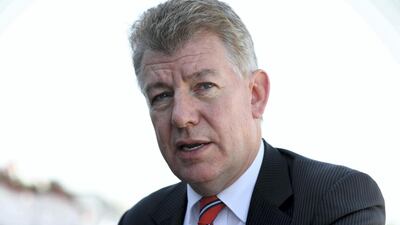The UAE will create “gates in the sky” to allow for simultaneous flight arrivals and departures, under its airspace restructuring project due to be completed next month, the chief executive of Dubai Airports said.
"At present, there are on average 37 arrivals at Dubai International Airport (DXB) per hour, versus 41 departures per hour, and the high arrivals rate is a major constraint on our capacity – slots are a bit of a challenge," Paul Griffiths said in an interview with The National.
“We want to increase the number of routes on which aircraft can be flowed into the airport to join or leave the departure or arrival pattern...The UAE airspace restructuring envisages a significant number of gates in the sky – around 13 compared to very few now – opening up to allow simultaneous arrivals and departures.”
This reconfiguration of the UAE airspace would enable Dubai Airports to operate “without delay on an enhanced capacity,” increasing runway movements, Mr Griffiths said, declining to give a target for percentage increase in movements.
_________________
Read more:
Dubai Airshow 2017: Crowds flock to day three - in pictures
Exclusive: Flydubai eyeing multibillion dollar 100-plus passenger jet order, chief executive says
In boon to Boeing, Emirates orders 40 Dreamliners worth $15.1 billion
__________________
The UAE’s General Civil Aviation Authority said last month it aims to complete a major airspace restructuring project by December 7, to “futureproof” the country’s skies for forecast traffic growth to 2040. The project has been described as one of the largest airspace changes the region has ever seen.
It comes as both Dubai’s Al Maktoum International Airport and Abu Dhabi International Airport undergo expansion. DXB is reaching capacity, with planes some times delayed in holding patterns before landing.
Mr Griffiths also wants the project to increase options for transitions between airspace regions across the GCC. “Because there’s no point having the capacity if you can’t operate a reliability and punctuality that makes it all work.”
He said he has made it clear to DANS (Dubai Air Navigation Services) that he wants no further capacity at the airport until performance has improved. “I want fewer delays and I’m prepared to take a capacity shortfall to deliver that as we do not want to offer a service that is not best in class,” Mr Griffiths said.
Ultimately, he wants the GCC to be a single airspace region like the European Union.
The Single European Sky is a European Commission initiative through which the design, management and regulation of airspace is coordinated by the EU, allowing aircraft movements to be scheduled across the whole region.
However, efforts to implement a similar initiative for the GCC have stalled amid regional political tensions at present.
“What we’d ultimately like to see is a coordinated airspace across the region,” Mr Griffiths said. “It’s impossible to get more efficiency out of the airspace unless you have an automated way of scheduling all the movements across the entire region.
“It’s taken years for [the EC] to get a grip on all of the European aerospace to make it more effective. The difficulty we have is that we don’t have Euro-style control; every country in the region has its own airspace management and that’s not very efficient.
“If we could get every country to cooperate on opening up the GCC to a single airspace region that would be a much better outcome,” he added.
He admitted this is a “political issue” and that progress had been slower than he would have liked, but said he was optimistic “we will get there eventually”.
“The cooperation we would need to make it something for the future is probably quite a long way from where we are at the moment. But as with most things I think there’s grounds for optimism that we will get there because everyone has a stake in the success of that route.”

